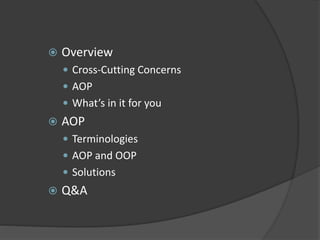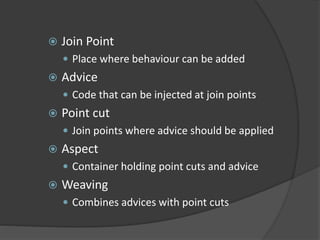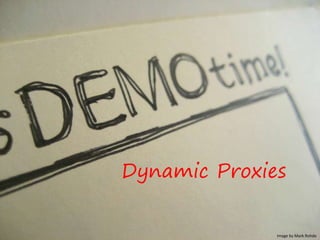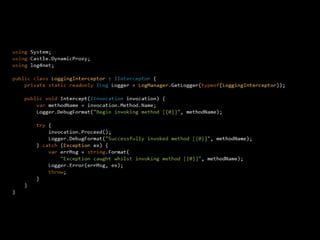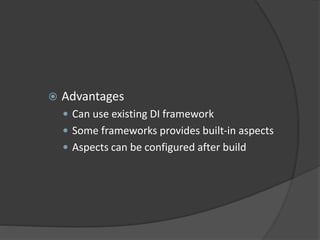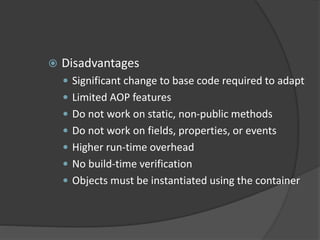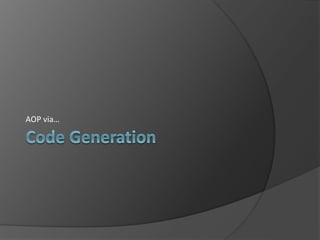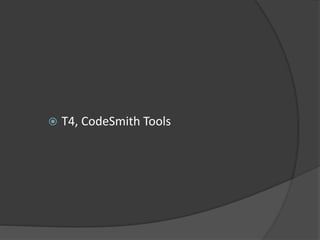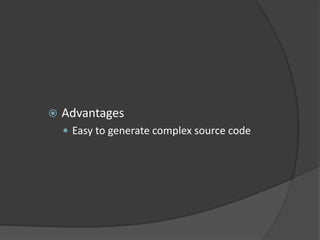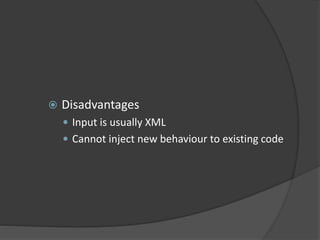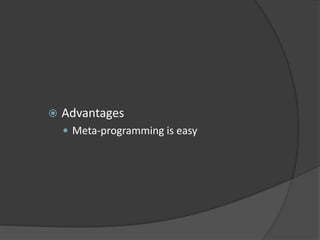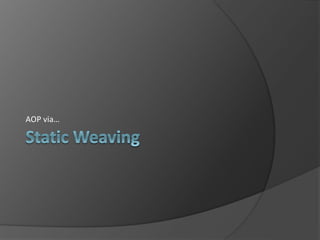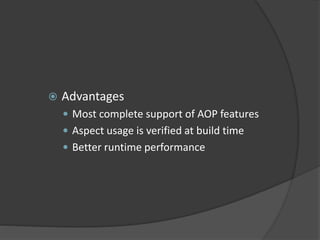Introduction to Aspect Oriented Programming
- 1. Yan Cui
- 2. Server-side Developer @ “Our mission is to build fun games and game apps that people can play, anywhere, anytime.”
- 3. Overview Cross-Cutting Concerns AOP What’s in it for you AOP Terminologies AOP and OOP Solutions Q&A
- 4. The PROBLEM…
- 5. Image by Mark RohdeImage by Mike Rohde Cross-Cutting Concerns
- 7. Cuts across multiple abstractions Difficult to decompose High-coupling Boilerplate code
- 8. Code tangling and scattering Poor traceability Lower productivity Less code reuse Harder refactoring
- 10. “AOP is a programming paradigm which aims to increase modularity by allowing the separation of cross-cutting concerns” - wikipedia
- 11. Coding is HARD AOP makes it EASY
- 13. Image by Mark Rohde AOP
- 15. Centralize concerns implementation Intercept method calls Inject new behaviour More reusable code Cleaner code
- 16. What’s in it for YOU?
- 17. Write less code Read less code More concise and easy to understand More maintainable
- 18. Fewer code = Less boilerplate code More interesting work Increased attention More PRODUCTIVITY! FEWER DEFECTS!
- 19. Diving a little deeper…
- 20. Join Point Place where behaviour can be added Advice Code that can be injected at join points Point cut Join points where advice should be applied Aspect Container holding point cuts and advice Weaving Combines advices with point cuts
- 21. AOP is complementary to OOP AOP targets a specific problem Code modularization OOP – Real world objects AOP – Functionalities
- 22. Help you S.O.L.I.Dify your code Single responsibility Open/close
- 23. You can do AOP via: Dynamic Proxies Functional Programming Code Generation Dynamic Languages Static Weaving
- 24. AOP via...
- 25. IoC framesworks (Castle, Spring.Net) Dynamic interceptors
- 26. Image by Mark Rohde Dynamic Proxies
- 28. Advantages Can use existing DI framework Some frameworks provides built-in aspects Aspects can be configured after build
- 29. Disadvantages Significant change to base code required to adapt Limited AOP features Do not work on static, non-public methods Do not work on fields, properties, or events Higher run-time overhead No build-time verification Objects must be instantiated using the container
- 30. Class, is AOP the same as Dependency Injection? NOOOO Sir!!
- 31. AOP via...
- 32. Image by Mark Rohde Functional Programming
- 34. Advantages No external dependencies
- 35. Disadvantages Requires modification to every function No support for matching rules Manual aspect composition
- 36. AOP via…
- 37. T4, CodeSmith Tools
- 38. Advantages Easy to generate complex source code
- 39. Disadvantages Input is usually XML Cannot inject new behaviour to existing code
- 40. AOP via…
- 41. Image by Mark Rohde Dynamic Languages
- 42. Advantages Meta-programming is easy
- 43. Disadvantages Switching to a dynamic language can be scary No (limited) Visual Studio tooling
- 44. AOP via…
- 45. PostSharp, AspectJ Uses low-level MSIL transformation Compile time
- 46. Aspect Decomposition Aspects Core program Aspect Recomposition Requirements Final System
- 47. Aspectual Decomposition Identify primary and cross-cutting concerns Concern Implementation Implement concerns separately Primary concern as Core Component using OO Cross-cutting concerns as aspect Aspectual Recomposition Aspect weaver to weave the separately implemented code into a final system
- 48. Image by Mark Rohde PostSharp
- 49. Advantages Most complete support of AOP features Aspect usage is verified at build time Better runtime performance
- 50. Disadvantages Increased build time New to many developers
- 51. PostSharp Training @ SkillsMatter, London January 19-20, 2012 http://www.sharpcrafters.com/training
Editor's Notes
- #6: Definition: A Cross-Cutting Concern is a concern your application needs to address that is unrelated to your application’s problem domain, and ‘cuts across’ other concerns. Examples: Typically non-functional requirements such as tracing, logging, persistence, transaction control, security, error handling Cross-cutting concerns are usually difficult to decompose from the rest of the system and results in: tangled code, concerns are interwoven with each other in a module scattered code, concerns are dispersed over many modules high coupling Addressing cross-cutting concerns usually means adding boilerplate code to your application, increasing both the size and complexity of your code, and the blast radius of any change that are not related to the problem domain, e.g. changing the persistence media.
- #8: Definition: A Cross-Cutting Concern is a concern your application needs to address that is unrelated to your application’s problem domain, and ‘cuts across’ other concerns. Examples: Typically non-functional requirements such as tracing, logging, persistence, transaction control, security, error handling Cross-cutting concerns are usually difficult to decompose from the rest of the system and results in: tangled code, concerns are interwoven with each other in a module scattered code, concerns are dispersed over many modules high coupling Addressing cross-cutting concerns usually means adding boilerplate code to your application, increasing both the size and complexity of your code, and the blast radius of any change that are not related to the problem domain, e.g. changing the persistence media.
- #9: Poor traceability – multiple concerns in the same module breaks linkage between requirement and its implementation, making it harder to understand what a piece of code is doing to address the problem domain. Lower productivity – developers are spending too much time and attention to peripheral issues rather than the problem domain. Less code reuse – boilerplate code propagated through cut and paste… no code reuse here! Harder refactoring – changing requirements means touching many modules for a single concern.
- #10: Which finally brings us to aspect oriented programming, and I’ll give you a second to read this quick definition from Wikipedia.
- #13: Take the ‘GetBookById’ method we ended up with earlier, now let’s give ourselves a magic hat and let the hat devour that ugly piece of code, and with a touch of AOP magic we’ll get back a cleaner, more elegant and readable version of the ‘GetBookById’ method. Under the hood, the two versions are the same, both log when they enter and exit the method, and both log any exceptions, also both versions of the code perform validation against the ‘id’ parameter to make sure that it’s not a default Guid.
- #15: Whist this is useful, it will still cause a lot of clutter when you have to apply the same set of attributes to many methods. But worry not, another feature of AOP is the ability to multicast the same aspects into many places in your code, this feature is called Point Cut.
- #16: To summarize, AOP allows you to centralize your implementation of cross-cutting concerns. It gives you a nice framework to intercept method calls and inject new behaviour with little change to your code. Once you’ve modularized your code that deal with the cross-cutting concerns, you are able to reuse them in other projects. This lets you write more reusable code and cleaner code.
- #17: That’s all very nice, but why should you care about writing reusable and clean code? What do you get out of it?
- #18: Well, for one, you end up writing less code, and therefore you will need to read less code too. The code that you end up reading will be more concise and easy to understand as they’re no longer convoluted by cross-cutting concerns. As you reduce the complexity of your code, it becomes more maintainable too.
- #19: Writing fewer lines of code means less chance for us to get it wrong, and therefore fewer defects in our code. You have to less boilerplate code, and that makes your work more interesting, and therefore you pay more attention to what you do. So all and all, you get a healthy boost of productivity when you take advantage of what AOP has to offer!
- #20: Now that you have a rough idea of what AOP is and how it can help you, let me help you get a sense of how you go about using it in practice. Before we do, let me give you a 2-minute crush course on the terminologies used in AOP.
- #21: Join points are places in your code where an aspect can be inserted, for example, before and after a method call, when a method excepts, or when field or property is being accessed. An advice is a piece of code that can be injected at join points to add new behaviour. This is the boilerplate that you had taken out from your code so that you can encapsulate it into an aspect and then inject it in whilst keeping your code pretty. A point cut is a set of join points where an advice can be applied. It can be attribute drive, like the earlier example of ‘GetBookById’ method where we applied the two attributes to the method. Or it can be filter driven, like the second example where we applied the attributes to the class instead and targeted methods that met our criteria. When a point cut is matched, advice can be executed. An aspect contains point cuts and advice, it is to AOP what class is to OOP, whereas classes holds methods and properties, aspects holds point cuts and advice. Weaving is the process of taking the advice and injecting them into the point cuts in the core component and compose the final result.
- #22: AOP and OOP are not mutually exclusive; AOP is in fact complimentary to OOP and help you become a better OOP developer by helping you enforce some important design principles of OOP. Unlike OOP, functional programming or declarative programming, which are general purpose paradigms aimed to solve most of the programming problems we face, and all competing to be the core paradigm of a language. AOP on the other hand, is a paradigm which attempts to solve one very specific problem. AOP and OOP both encourage code modularization and encapsulation, which leads to better code reusability and maintainability. The difference between the two paradigms come in the form of WHAT they modularize on: - OOP modularizes on basis of real world entities AOP modularizes on basis of functionalities
- #23: For those of you who aren’t familiar with the SOLID principles, they stand for: Single responsibility principle: an object should have only one responsibility Open/Close principle: objects should be open for extension, but closed for modification Liskov substitution principle: objects should be replaceable with instances of their subtypes without altering the correctness of that program Interface segregation principle: many specific interfaces are better than one general purpose interface Dependency inversion principle: one should depend upon abstraction rather than implementations These are 5 principles that can help you create more maintainable software with fewer defects. Most of you should be familiar with the dependency inversion principle already because that’s the problem that IoC frameworks solve and IoC frameworks are extremely popular nowadays. You can use AOP to help you better adhere to these principles, for instance, by using AOP to remove the cross-cutting concerns from your core program it becomes easier for you to follow the single responsibility principle. Similarly, using point cut and multicast attribute as I demonstrated earlier, you are able to inject new behaviour into existing classes without modifying them, hence not breaking the open/close principle.
- #24: So hopefully that’s sufficient evidence for you to want to give AOP a go, but in terms of actually start doing some aspect-oriented programming you have quite a number of different options, including: Dynamic proxies with IoC frameworks - Functional programming using higher-order functions - Code generation using tools like T4 - Dynamic languages using their meta-programming capabilities - Static weaving, by modifying the MSIL in a post-compilation process
- #26: Dynamic proxies are supported in IoC frameworks such as Castle or Spring.net, and here’s a simple example of a logging interceptor that logs the entry and exit of a method and any unhandled exceptions that bubbles out of the method.
- #29: If you are using a dependency injection framework already, and all you want is to be able to intercept method calls and inject additional behaviour, then dynamic proxies represent the easiest way for you to adopt AOP in your project right away. Also, some frameworks provide built-in aspects such as the logging aspect I showed you earlier. Most such frameworks also allow you to configure aspects through configuration files, making it easier for you to make changes in a live environment without having to compile and deploy any code changes.
- #30: However, dynamic proxies only offer a limit set of AOP’s features, and if you’re not already using a dependency injection framework, adopting it into an existing code base will require a significant amount of work and change. There are also a number of restrictions, dynamic proxies do not work on static, or non-public methods, and they do not work on fields, properties or events. Since aspects are applied at runtime, there is a higher runtime overhead than there is with build-time AOP frameworks. However, this is only likely to cause a noticeable impact on your application’s performance if you’re generating large numbers of dynamic proxies. The bigger drawback is the lack of build-time verification to make sure that you’re using the aspects incorrectly. But for me, the biggest problem with using dynamic proxies is that it only works if your objects are instantiated using the container. This can cause major confusion to the consumers of your code, because when they instantiate the instances themselves the injected behaviours will not be present. That is not always clear, and without looking into your code and your container configuration it’ll be difficult to figure which behaviours were injected and which weren’t. This is one area where hard-to-detect bugs can creep in and you won’t see it until things blow up at runtime! Nasty stuff!
- #31: Because IoC frameworks are so commonly used these days, and a lot people have their first experience with AOP through the use of dynamic proxies, many people have associated dependency injection with AOP. Well, I’m here to tell you that the two are not the same, at all! Dependency injection is a design pattern that addresses the problem of writing loosely-coupled components together, and helps you enforce the practice of design by contract. You program to an abstraction/interface rather than an implementation, and instead rely on the container to provide the concrete implementation at runtime. AOP on the other hand, addresses a very different issue: cross-cutting concerns as I showcased earlier. Dependency injection became associated with AOP because it just happens to be in a convenient place to allow users to inject new behaviours to existing code base transparently.
- #34: That is the essence of the memoization technique, which I’ll show you right here with this bit of F# code. Don’t worry about the syntax; the important thing to note here is that this function takes another function as input, and use a dictionary to cache results before returning a modified version of the original function. …DEMO… The memoize function is simple and yet effective, however, it breaks down when you use it with a recursive function. It’s not hard to fix it, but the whole AOP experience here is just not quite transparent and unobtrusive as you’d like.
- #35: The advantage of doing AOP in functional programming is that you don’t require any external dependencies as you do with dynamic proxies and static weaving, instead you write everything as higher-order functions in the language you’re already familiar with.
- #36: But, as I have demonstrated with recursive function, if you want to use the memoized version of the function f everywhere in your code, you’ll need to modify all the places where f is being used. Also, there’s no support for matching rules that lets you apply the same aspect to multiple functions in bulk. And when you want compose different aspects together, i.e. combining multiple higher-order functions, you’ll need to do it manually which is a task that’s easier said than done.
- #48: A static weaving solution AOP usually involve a three phase implementation: Aspectual decomposition – based on requirements, identify concerns as either primary (problem domain) and cross-cutting Concern implementation – code each concern separately, primary (OO) and cross-cutting (AO) Aspectual recomposition – use aspect weaver to weave the separately implemented code together into a final system



